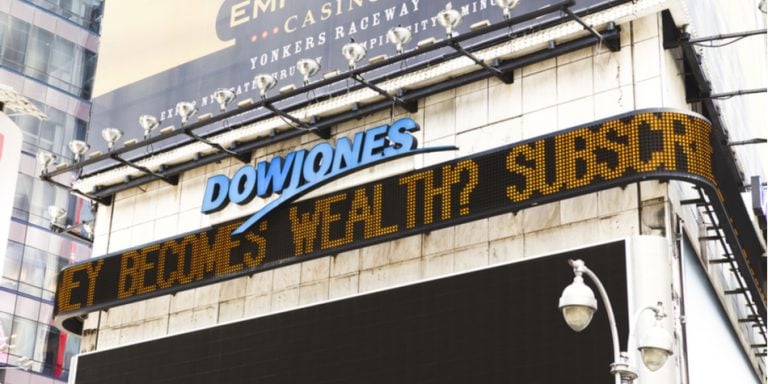Many investors, especially the ones who only invest for retirement, prefer to stay away from individual stocks. Of this group, many simply want to follow indexes. Indexes like the S&P 500 or the Dow Jones Industrial Average in the United States offer a barometer of overall stock market performance. Despite the S&P covering more stocks, the popularity of the Dow 30 continues. Fortunately, investors who want to invest in the Dow Jones can choose from a wide array of exchange-traded funds.
Wall Street Journal and Dow Jones & Co. co-founder Charles Dow created the index in 1896. Today, the index consists of 30 large-cap stocks that define the overall market. As the name implies, it started out as an index of “industrial” stocks. As the index came to represent the overall market, the Dow Jones added non-industrial companies over time.
The index has also seen stocks added and removed as their size and importance increased or decreased. Companies such as Walgreens (NASDAQ:WBA) and Apple (NASDAQ:AAPL) make up recent additions to the index. Firms such as AT&T (NYSE:T) and Sears (NASDAQ:SHLD) found themselves removed from the index as their importance declined. The Dow Jones eliminated the last original member of the index, GE (NYSE:GE), from the index this year.
ETFs Offer the Only Pure Play on the Dow Jones
Although mutual funds that can track the Dow Jones exist, ETFs usually serve this purpose at a lower cost. For example, the two Rydex Dow Jones Industrial Average Funds (MUTF:RYDAX, MUTF:
RYDHX) place just over 80% of their assets in Dow 30 stocks. The remainder is split up between derivative instruments and cash. These require a minimum $2,500 investment and charge fees exceeding 1.55%. The same issues exist with the Rydex inverse funds that bet against the Dow.
For a Dow Jones pure play, no fund comes closer than the SPDR Dow Jones Industrial Average ETF (NYSEARCA:DIA). Global State Street Advisors established this fund in 1998. Barring the purchase of all 30 stocks at their specific weighting, DIA stock stands as the closest approximation to the Dow Jones available. As the name implies, it invests 99.8% of its assets in all 30 Dow stocks and it mimics the actual index in weighting. The fund charges an expense ratio of 0.17%, almost 90% less than the fees for maintaining RYDAX or RYDHX.
Leverage and Inverse Dow ETF Funds Are Also Available
Other indexes act as variations on the Dow. ProShares offers two leveraged Dow ETFs. The ProShares Ultra Dow30 (NYSEARCA:DDM) reflects two times the daily performance of the Dow Jones. It achieves this by owning the overall stocks as well as derivatives and money market funds. Achieving such performance involves more active management. Hence, this fund charges a much higher expense ratio — 0.95%.
By the same token, the ProShares UltraPro Dow30 (NYSEARCA:UDOW) mimics three times the daily performance in the same manner. Its expense ratio also comes in at 0.95%. Fortunately for their long-term investors, the decay factors that often affect leveraged ETFs have not sent these funds into a long-term decline. In fact, DDM has outperformed the overall Dow Jones, even when factoring in the effects of the 2008 financial crisis. Despite that, huge moves upward can turn into severe spikes downward when the momentum shifts, so approach these leveraged ETFs carefully.
ProShares also offers an ETF for those that want to bet against the Dow 30. As the name implies, the ProShares Short Dow30 ETF (NYSEARCA:DOG) moves in the opposite direction of the Dow. However, investors should only buy this equity in or near a bear market. Since the Dow has seen a steady rise since 2009, DOG stock has itself become a dog. After moving above $360-per-share in Mar. 2009, it has steadily dropped on the rising Dow Jones average. Today DOG trades at about $57-per-share.
Final Thoughts on Dow Jones Investing
ETFs offer investors a wide variety of ways to invest in the Dow Jones index at an affordable price. Such funds allow investors to invest in the Dow without purchasing all Dow 30 stocks at their specific weights.
Although investors can use mutual funds, they typically charge higher fees and do not cover the index as closely. DIA stock offers the only true pure play in Dow Jones investing. However, other funds also allow for investing at multiples of the index or for shorting it.
Not all investors want to invest in the Dow Jones. However, thanks to index funds, those that want a Dow tracker can invest in the Dow 30 according to their beliefs about its future performance and their risk tolerance.
As of this writing, Will Healy did not hold a position in any of the aforementioned stocks. You can follow Will on Twitter at @HealyWriting.

